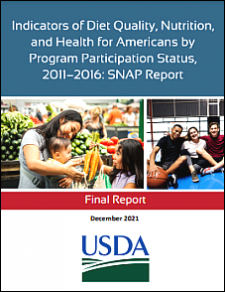 Summary (313.96 KB)
Summary (313.96 KB)
 Final Report (11.50 MB)
Final Report (11.50 MB)
 Appendix A: Data and Methods (943.66 KB)
Appendix A: Data and Methods (943.66 KB)
 Appendix B: Healthy Eating Index (1.23 MB)
Appendix B: Healthy Eating Index (1.23 MB)
 Appendix D: Food Consumption Patterns (4.28 MB)
Appendix D: Food Consumption Patterns (4.28 MB)
 Appendix F: Usual Micronutrient Intakes (2.87 MB)
Appendix F: Usual Micronutrient Intakes (2.87 MB)

|
The Supplemental Nutrition Assistance Program (SNAP) is the largest domestic food and nutrition assistance program administered by the Food and Nutrition Service. The aim of SNAP is to increase food security and ensure low-income households have access to nutritious food. This study is the fourth in a series that uses the National Health and Nutrition Examination Survey (NHANES) data to examine the relationship between SNAP participation and indicators of diet quality, nutrition, and health. As in previous studies, this study compares SNAP participants with income-eligible and higher income nonparticipants, by age and gender. This study presents differences between SNAP participants and nonparticipants, but it does not assess the impact of SNAP on reported outcomes or infer causality. This presents results of descriptive analyses comparing data on SNAP participants with income-eligible (less than or equal to 130 percent of federal poverty level) and higher income nonparticipants for all individuals and by three age groups (children 18 years of age or younger), adults (19 to 59 years of age), and older adults (60 years or older) and by gender. Findings from matched and regression analyses are presented in the report and appendixes. |

